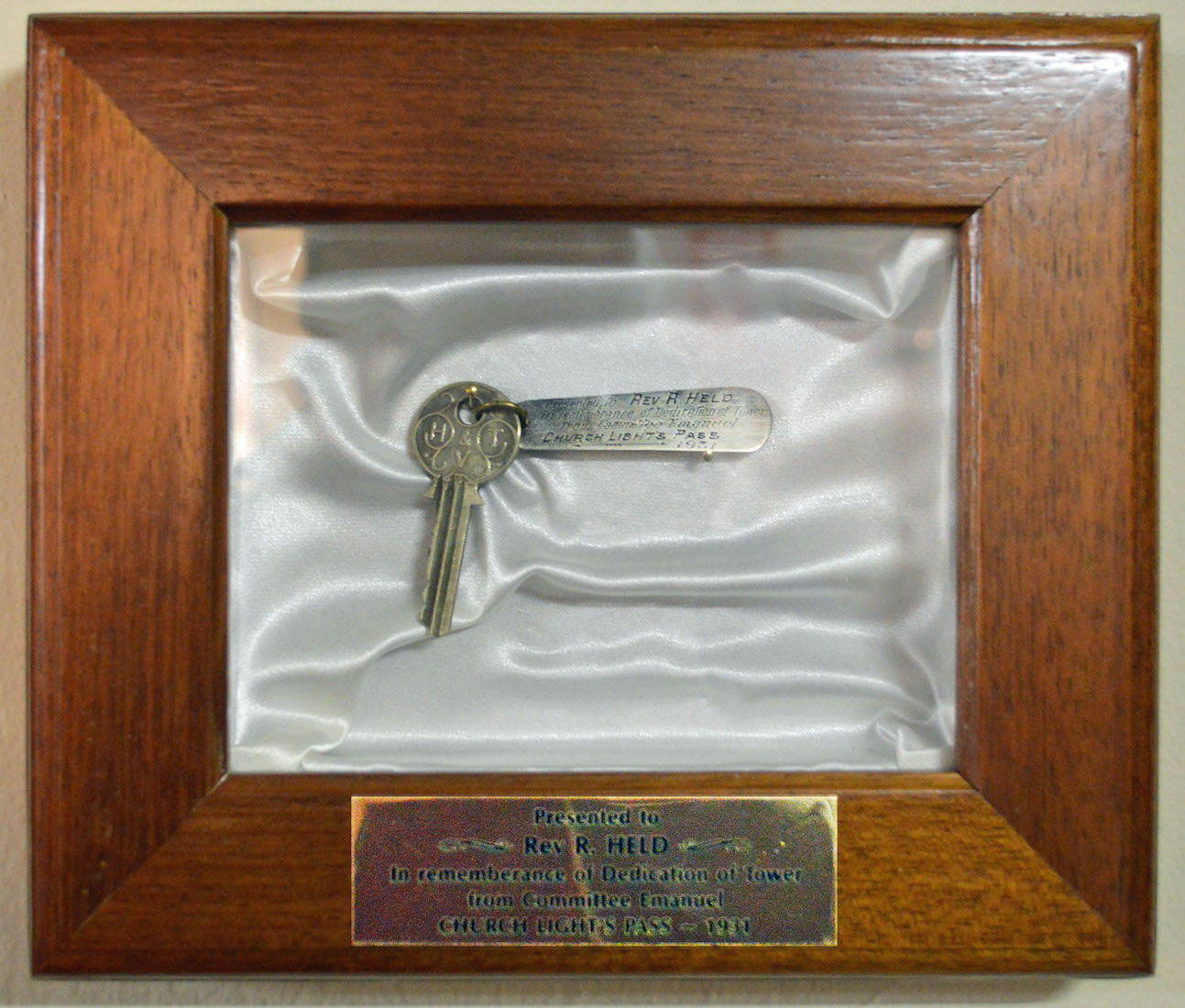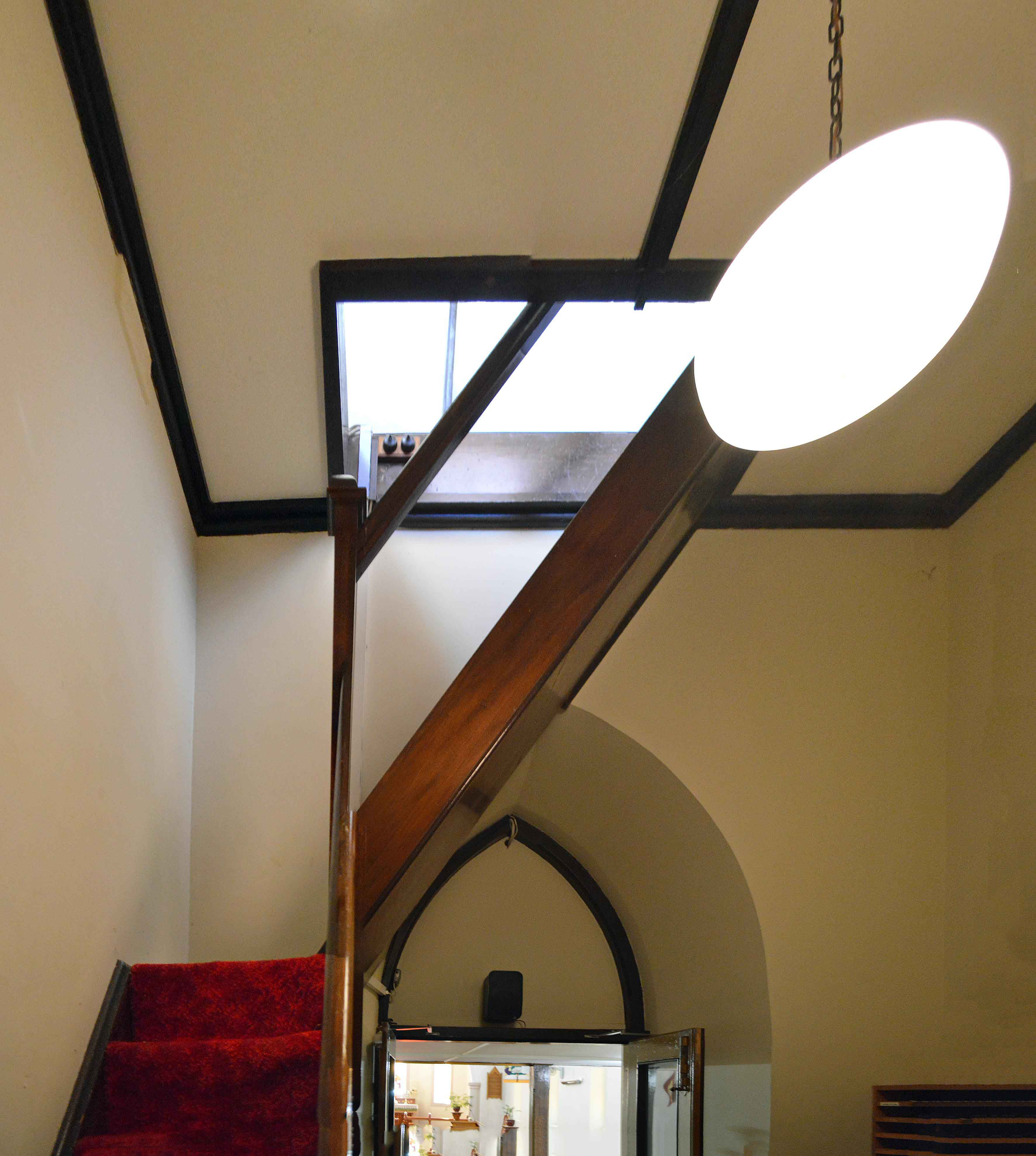22. NORTH WINDOWS

We notice that these four windows are the same, apart from the central blue feature. From left we have: • a butterrfly; • the IHS cryptogram for Christ with the ‘I” modified to be a Cross; • a fish and anchor; • an oil lamp above an open Bible.
23. SOUTH WINDOWS
On this side, the central blue motifs are: • the Nativity star; • the Lutheran seal or rose; • a sailing ship; • crown and cross; • theChi-Rho, and Alpha and Omega signs for Christ.
24. THE WINDOW MOTIFS
Here we have a closer look at the nine motifs. The butterfly can be seen as a symbol of the Resurrection. Scripture uses the anchor as a symbol of Christian hope in Hebrews 6:19. The fish is another symbol of the Christian faith. The Lutheran rose or seal was used by Martin Luther as a symbol of his belief. The ship is a symbol of the Christian Church.
25. BALCONY
The rear balcony at the Western end supports the console and pipes of the organ. We notice the two West-facing windows. More modern touches are the television screen at centre, the data projection unit at top right, and the PA control system behind the pews at bottom right. Just to the right of the rear doors is a curious framed object.
26. PA SYSTEM
I was initially surprised at finding this in such a little church, but it does mean that they can dispense with using hymn books.
27. TOWER KEY
The mysterious object by the West doorway turns out to be a key to the tower which was presented to Rev R Held in remembrance of the dedication of the tower, ‘from Committee Emanuel Church Light’s Pass ~ 1931’.
28. TOWER STAIRS
The stairs up to the tower, and also to the balcony, are in the entry space at the base of the tower.
29. ORGAN
The first organ in this Church was constructed by Daniel Lemke, Adelaide, 1876, for the former church. It was installed in the present church in 1886. It remained in service until its removal in 1961. The present organ was constructed and installed by Davis & Laurie, Melbourne, in 1962. Its description is: 1 manual, 3 ranks extended, electro-pneumatic action.
30. RINGER’S ROOM
From the balcony I manage to make my way up to the ringer’s room. After the tower was added in 1930, a new steel bell was installed. It was presented by J.C.F. Zeunert, and fabricated by George V. Bochumer, of Verein Bochum, Germany. The bell has a single word inscribed with the date, ‘Immanuel 1930’ and rings the tone of G#. It measures 43" x 35" (1092mm x 889mm) and weighs 515kg. The bell swings on a rocking type of axle with teeth known in German as a Zahnkranz-Rollager, not uncommon in 19th century Germany but very rare in Australia. The first bell was given to the Lutheran church in Cummins.
31. BALCONY VIEW
From the balcony we get a high view out over the Church interior.
32. BANNERS
Two colourful banners decorate the front of the nave. The ‘Come Holy Spirit’ banner combines the images of descending dove and flames. The thoughtful ‘God with us’ banner at right is made up of images of Immanuel Church and the Lutheran beliefs.
33. FONT
The centrally placed font is of the type commonly found in the Valley churches, although a little more decorated. The rim of the font features the words of Jesus (in German): ‘Suffer the little children to come unto me’. A gleaming silver jug stands on top. The font was given in memory of Johann Lowke.
34. PULPIT
The attractive little pulpit stands close to the door through to the vestry. The front green and gold banner carries the IHS ‘Jesus’ symbol. The sermon is given from here, Sunday by Sunday.
35. LECTERN AND CHAIR
A nicely carved lectern stands on the other side of the Church. This would normally hold a Bible, and Scripture readings would be given from here. Behind stands a matching celebrant’s chair.
36. SANCTUARY
At the East end of the Church there is an apse which defines the sanctuary. The altar stands behind an altar rail, and behind are three special windows. The discussions about the placing of the altar and the priest facing the congregation for the administration of the Eucharist do not seem to have reached the Valley churches.
37. SANCTUARY WINDOWS
The sanctuary windows continue the theme of the Cross with the central blue motif. These windows have a Trinity theme: from right to left showing the Father (Hand of blessing), the Son (Lamb with Banner) and the Holy Spirit (Dove). The central window also has a depiction of the Last Supper.
38. ALTAR SETTING
On the altar we find various candles, a crucifix, and the Word of God in prominent position. The words ‘Holy + Holy + Holy’ are arrayed across the back. The placing of the crucifix unfortunately obscures the depiction of Christ in the window behind!
39. THE LAST SUPPER
The scene depicted at the base of the central sanctuary window shows Jesus meeting with eleven of his disciples at the Last Supper. An empty chair marks where Judas had been sitting.
40. ALTAR
The altar is the place from where the Elements of the Eucharist are administered. The Eucharist is the central celebration in which the death of Christ on the Cross is remembered.




















